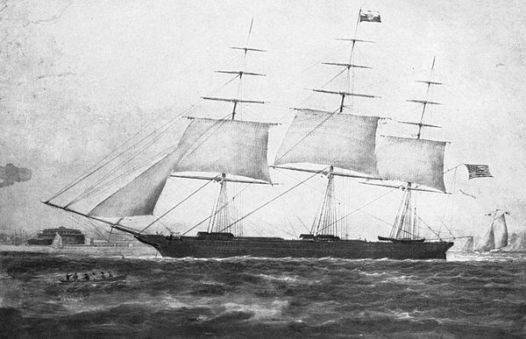They sure are – at least in NYC’s Times Square and in my debut novel Aquavit. But don’t plan a cruise even though this ship is not too far from the Hudson River. This is a piece of art and a skeleton ship. And the one in my novel Aquavit, the Anne Kristine from 1852, is 100% imaginary.
The clipper ship creator, Texan Mel Chin, is a conceptual artist which means he prizes ideas over his art’s visual components. Chin built the clipper ship art to challenge our concept of how we think about it. Since so few clippers ships still exist, this requires quite a bit of imagination.
From the exhibit:
According to the signs at the exhibit entitled WAKE, he modeled his ship on the USS Nightingale. The artwork has a massive figurehead and pieces of the hull, like the bones of a whale, supporting her. The real USS Nightingale was a 19th-century expedition and merchant clipper ship carrying coal, cotton, munitions, and tea.
The figurehead represents Jenny Lind, a famous Swedish opera star called the Swedish Nightingale. This exhibit is hard to miss if you are in Times Square, but it ends September 5, 2018.
I had to know more about his model ship. According to Wikipedia, this clipper was built in 1851 in Maine, but her original name, source unknown, was the Sarah Cowles. Her name was changed to the Nightingale when Jenny Lind toured the USA in the 1850’s.
The Nightingale competed in races to bring tea and silk from China to England. She was faithful to her name, went at a fast clip, and set records. She also carried passengers from Boston and New York to Australia for the gold rush.
Drawing of the real ship courtesy of Wikipedia:

The Nightingale’s ownership passed hands to Brazilians, and she was captured by the USS Saratogaoff the coast of Africa in 1861 with slaves on board. After the release of the slaves and a trial, the U.S. Navy purchased her adding USS to her name. She became a supply ship and collier (coal carrier) for the Union’s Navy in the Civil War and part of the blockade to stop Confederate ships. She ran aground but was refloated and sailed back to New York.
After the civil war, she was the flagship for Western Union in San Francisco and explored British Columbia, Alaska, and Siberia to lay telegraph cables across the Bering Sea. A Norwegian company acquired her in 1877. But six years later, she floundered and was abandoned at sea in the North Atlantic on the way from Liverpool, England to Halifax, Canada. This treacherous route resulted in the demise of many beautiful clippers. But at least she sailed for 32 years!
In the 19th-century, her figurehead was removed by the Norwegian owners while undergoing repairs and was found not long ago at a farm in Norway. A Swedish antique dealer purchased the last remaining piece of the Nightingale in 1994. A fitting end: the Swedish opera star returned to her home country.
If you are in New York City, stop by to see her. She has a mechanical neck that should move, but according to a friendly NYPD officer, it hasn’t worked yet. The artist may not have known that a true clipper ship didn’t have engines onboard, and many of their captains hated any attempts to modernize them.
If you like the idea of taking a cruise on a real clipper ship, check out my novel Aquavit. Or take a real cruise offered through Star Clippers on a modern rebuilt clipper ship. I went on a one-week cruise from Athens last year and can’t wait to do this again.
Karen Stensgaard is the author of the novel AQUAVIT, the first book in the Aquamarine Sea Series with a second novel on the way soon. AQUAVIT is available as a paperback from Amazon and Ingram Spark or as an e-book from almost everyone else. Libraries have free access via Overdrive. Link to free chapters on Amazon












